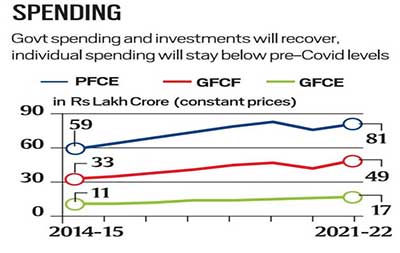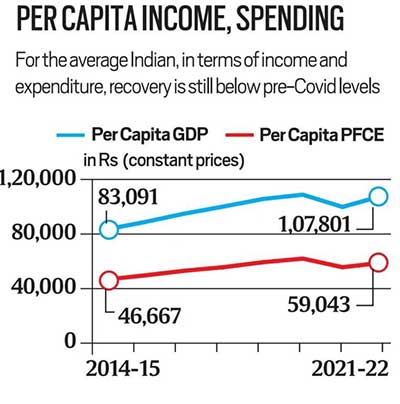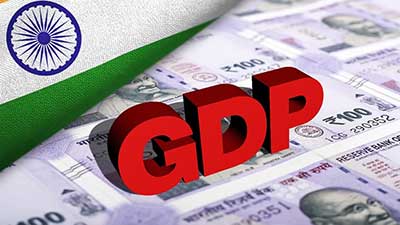Relevance: GS-3: Indian Economy, mobilization of resources, growth and development.
Key phrases: GDP, Real GDP, Nominal GDP, Advance Estimates, growth rate, GVA, spending, consumption, expenditure
Why in News?
- The First Advance Estimates project a GDP growth of 9.2%, after a contraction in the last fiscal. What do the data reveal about the economy, and the average Indian's income and purchasing power.
What are the First Advance Estimates of GDP?
- The FAE, which were first introduced in 2016-17, are typically published at the end of the first week of January.
- They are the “first” official estimates of how GDP is expected to grow in that financial year. But they are also the “advance” estimates because they are published long before the financial year (April to March) is over.
Gross Domestic Product
- GDP is the final value of the goods and services produced within the geographic boundaries of a country during a specified period of time, normally a year. GDP growth rate is an important indicator of the economic performance of a country.
- It can be measured by three methods, namely,
- Output Method: This measures the monetary or market value of all the goods and services produced within the borders of the country. In order to avoid a distorted measure of GDP due to price level changes, GDP at constant prices real GDP is computed. GDP (as per output method) = Real GDP (GDP at constant prices) – Taxes + Subsidies.
- Expenditure Method: This measures the total expenditure incurred by all entities on goods and services within the domestic boundaries of a country. GDP (as per expenditure method) = C + I + G + (X-IM) C: Consumption expenditure, I: Investment expenditure, G: Government spending and (X-IM): Exports minus imports, that is, net exports.
- Income Method: It measures the total income earned by the factors of production, that is, labour and capital within the domestic boundaries of a country. GDP (as per income method) = GDP at factor cost + Taxes – Subsidies.
- In India, contributions to GDP are mainly divided into 3 broad sectors – agriculture and allied services, industry and service sector. In India, GDP is measured as market prices and the base year for computation is 2011-12. GDP at market prices = GDP at factor cost + Indirect Taxes – Subsidies
What is their significance?
- The main significance of FAE lies in the fact that they are the GDP estimates that the Union Finance Ministry uses to decide the next financial year’s budget allocations.
- From the Budget-making perspective, it is important to note what has happened to nominal GDP, both absolute level and its growth rate. That’s because nominal GDP is the actual observed variable. All Budget calculations start with the nominal GDP.
- However, from the perspective of the common people, real GDP is what matters. The difference between the real and nominal GDP shows the levels of inflation in the year.
Key points:
Real GDP Growth:
- At 9.2%, the real GDP growth rate for FY22 is slightly lower than most expectations, including RBI’s, which pegged it at 9.5%.
- As things stand, aggregate GDP in FY22 is estimated to cross the pre-Covid level (see photo). This also holds true for the absolute level of Gross Value Added (GVA).

Role of High Inflation:
- For FY22, while real GDP (that is, GDP calculated using constant 2011-12 prices) will grow by 9.2%, nominal GDP (that is GDP calculated using current market prices) will grow by a whopping 17.6%. The difference between the two growth rates about 8.5 percentage points is essentially a marker of inflation (or the rate at which average prices have increased in this financial year).
Low Private Consumption:
- An analysis of the three main contributors to GDP: private consumption demand, investments in the economy, and government expenditures, shows that while the latter two are expected to claw back to the pre-Covid level, the first engine will continue to stay in a slump.
- Private consumption expenditures typically account for more than 55% of all GDP. As photo shows, its level is expected to stay substantially the 2019-20 level. Such weak levels of private demand will make it difficult to sustain economic growth in the months and years ahead.

Average Indian is much worse off:
- While aggregate GDP and GVA numbers may recover the same cannot be said about an average Indian. Two data points prove this.
- The Graph below shows ( per capita income and spending) per capita GDP (a proxy for average income) and per capita Private Final Consumption Expenditure (a proxy for average spending). At the end of March 2022, while the average income is estimated to be below March 2020 level, the average spending will be lower than even the March 2019 levels, which marks the start of the second term of the BJP government.
- In other words, an average Indian has lost 2 years in terms of income levels and 3 years in terms of spending levels. What’s more, even these average numbers do not capture the acute pain because of the growing inequalities in the country. For the bulk of the Indian population, thus, aggregate data recovering to pre-Covid levels may be largely academic.

GDP vs GVA
- While the GDP maps the economy from the expenditure (or demand) side that is by adding up all the expenditures, the GVA provides a picture of the economy from the supply side. GVA maps the “value-added” by different sectors of the economy such as agriculture, industry and services.
Way forward:
- It is important to note that even though the FAE are published soon after the end of the third quarter (October, November, and December), they do not include the formal Q3 GDP data, which is published at the end of February as part of the Second Advance Estimates (SAE). These estimates are based on data before the rise of the Omicron variant. As such, there is a possibility that the final rate may be revised further downwards by May-end when the full financial year’s “provisional” estimates will be published. So, In times of such massive upheavals, it is always better to look at the absolute levels instead of growth rates.
Source: Indian Express
Mains Question:
Q. The First Advance Estimates project a GDP growth of 9.2%, after a contraction in the last fiscal. Explain what is Nominal GDP? Why GDP growth rate is an important indicator of the economic performance of a country? Illustrate.









